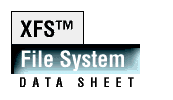This document (dated 1/16/96) hails from http://www.sgi.com/Products/hardware/challenge/XFS/XFS.html
-- always reference the above link, for the most current, up-to-date
version of this page.


![[photo]](/file/12033/SGI Developer Toolbox 6.1 - Disc 1.iso/toolbox/documents/networking/XFS.gif) Introducing XFS, XFS(tm) is the next-generation file system for Silicon Graphics® systems, from desktop workstations to supercomputers. XFS provides full 64-bit file capabilities that scale easily to handle extremely large files and file systems that grow to 1 terabyte. The XFS file system integrates volume management, guaranteed rate I/O, and journaling technology for fast, reliable recovery. File systems can be backed up while still in use, significantly reducing administrative overhead.
Introducing XFS, XFS(tm) is the next-generation file system for Silicon Graphics® systems, from desktop workstations to supercomputers. XFS provides full 64-bit file capabilities that scale easily to handle extremely large files and file systems that grow to 1 terabyte. The XFS file system integrates volume management, guaranteed rate I/O, and journaling technology for fast, reliable recovery. File systems can be backed up while still in use, significantly reducing administrative overhead.

- XFS utilizes database journaling technology to provide high reliability and rapid recovery. No file system checker is necessary after a system crash: log-based recovery will recover a file system within a few seconds. XFS recovery time is independent of file system size.
Journaling permits XFS to use more advanced and efficient on-disk structures to store file system information such as block free lists, file extent lists (indirect block replacement), and directories.

- The XFS volume manager, XLV, is a superset of the existing Silicon Graphics lv volume manager and supports striping, concatention, and disk plexing (mirroring). With XLV, an XFS root partition may be plexed. XLV supoprts on-line dynamic changes to volumes, including extending the size of a mounted filesystem. XLV partitions can be used for XFS or EFS filesytems or raw database partitions. A utility is provided to convert lv volumes to XLV without having to dump and restore your data.

- XFS is the only file system available that provides a guaranteed rate I/O system, which allows applications to reserve specific bandwidth to or from the file system. The file system can determine the available bandwidth and guarantee that a requested level of performance is met for a given time. This frees programmers from having to predict performance, which can be complex on systems as flexible as CHALLENGE(tm) servers. This functionality is critical for media delivery systems such as video-on-demand or data acquisition.

- XFS is designed for a very high performance; sustained throughput in excess of 300MB per second has been demonstrated on CHALLENGE systems.
The XFS file system scales in performance to match the CHALLENGE MP architecture. Traditional files, directories, and file systems have reduced performance as they grow in size. With the XFS file system, there is no performance penalty. For example, XFS directories have been tested with up to 32 million files in a single directory.

- The Silicon Graphics' implementation of Network File System(tm) (NFS), an industry standard for distributed file systems, offers the highest performance on the market. CHALLENGE servers with XFS are designed to take full advantage of this performance.
NFS 5.3 allows you to export 64-bit XFS file systems to other systems. You can use the interfaces supplied with XFS to write 32-bit programs that can track 64-bit position and file size. By using NFS and XFS in combination, you overcome the limits of 32-bit systems. Existing software will run with XFS without recompilation in files up to 2GB; depending on the application, changes may be required to support larger files.

- The XFS file system allows you to create file systems with block sizes which range from 512 bytes to 1MB. File system extents, which provide contiguous data within a file, are configurable at file creation time and are multiples of the file system block size. The contiguous data control feature of XFS increases performance because there is no delay in accessing your data. Individual contiguous extents can be as large as 1TB.

- Unlike traditional file systems, which must be dismounted to guarantee a consistent dump image, you can dump an XFS file system while it is being used. The XFS dump utility, XFSdump, can dump an entire filesystem, a directory tree, or specific files. XFSdump is restartable, which allows a large dump to be spred over an extended period of time or to be resumed after a system restart. The dump program can re-archive files which were changed since the beginning of the dump.

- XFS is not a re-write of an existing file system technology with a few features added. It was designed to meet today's needs and the requirements of the next decade. XFS consistently scales well from small to truly huge amounts of data and huge numbers of files. XFS provides very high performance that can be guaranteed, and has database technology at its heart for mission-critical reliability.
Copyright © 1995, Silicon Graphics, Inc.



![[photo]](/file/12033/SGI Developer Toolbox 6.1 - Disc 1.iso/toolbox/documents/networking/XFS.gif) Introducing XFS, XFS(tm) is the next-generation file system for Silicon Graphics® systems, from desktop workstations to supercomputers. XFS provides full 64-bit file capabilities that scale easily to handle extremely large files and file systems that grow to 1 terabyte. The XFS file system integrates volume management, guaranteed rate I/O, and journaling technology for fast, reliable recovery. File systems can be backed up while still in use, significantly reducing administrative overhead.
Introducing XFS, XFS(tm) is the next-generation file system for Silicon Graphics® systems, from desktop workstations to supercomputers. XFS provides full 64-bit file capabilities that scale easily to handle extremely large files and file systems that grow to 1 terabyte. The XFS file system integrates volume management, guaranteed rate I/O, and journaling technology for fast, reliable recovery. File systems can be backed up while still in use, significantly reducing administrative overhead.